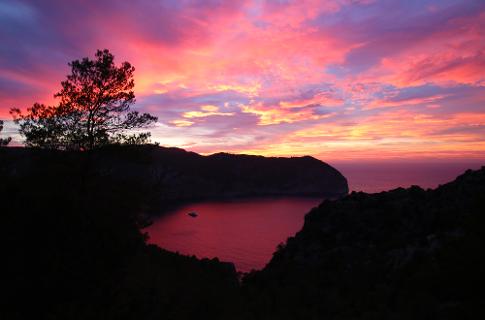
Ibiza | Sport Climbing on the Party Island
Located in the western Mediterranean, approximately 100km off the Costa Blanca, Ibiza is the third largest of Spain’s Balearic Islands.
For most people, the island conjures up images of drunken debauchery; of all-night parties, raves, revelry and hedonistic excess. It’s the archetypal party destination for the younger generation. Lazy afternoons on the beach are as much about recovering from the night before as anything else, before the island once again comes alive as the sun sets on the turquoise waters of San Antonio Bay.
Since the opening of the iconic Pacha in 1973, the list of big-name dance venues on the island has grown to include some of the most famous clubs on the planet, establishing Ibiza as the clubbing capital of the world. It hardly seems like the kind of place that would appeal to climbers.
In fact, Ibiza’s long-standing association with beach parties, nudity and booze goes back a very long way, to when Phoenician settlers first arrived in 654 BC. On doing so, they discovered an island with a favourable climate and a conspicuous absence of venomous creatures. They were so impressed by the unusually hospitable environment, they named the island after Bes, the Egyptian deity known for killing snakes, fighting off evil, and protecting households, mothers, children and childbirth. Over time, Bes came to symbolise the good things in life: wine, music, dance and revelry.
Hedonism has, therefore, not merely been tolerated but has been an underlying part of Ibiza’s culture throughout its history. When tourism really started to take off in the 1950s, it is not surprising that the island found favour with more bohemian types, quickly becoming popular with hippies and free-spirits from around Europe.
Today, Ibiza sees as many as 3 million tourists passing through in a typical summer season, with most of this influx being absorbed by the two main towns – San Antonio (Sant Antoni) on the west coast and Ibiza Town (Eivissa) in the south.
Away from the towns however, lie the hidden secrets of the ‘Party Island’. Rolling hills lead to a dramatic coastline of remote limestone cliffs, crystal-clear waters and idyllic beaches. Old lookout towers, fortified churches and legendary cave systems hint at a fascinating history of pirates and smugglers. Peaceful fincas, surrounded by vines and olive plantations, are worlds away from stereotypical expectations.
For climbers, Ibiza’s northern coastline might just be one of the Mediterranean’s best-kept secrets, particularly if you’re looking for somewhere a bit different from the mainstream resorts of Greece and Spain. The atmosphere is amazingly relaxed, the people friendly, and the crags are often deserted. Routes are well bolted, with grades to suit most abilities and ambitions.
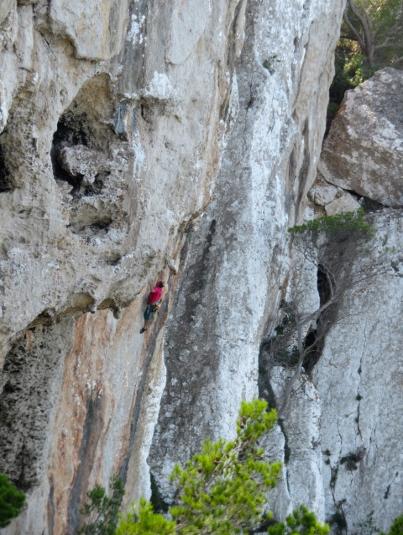
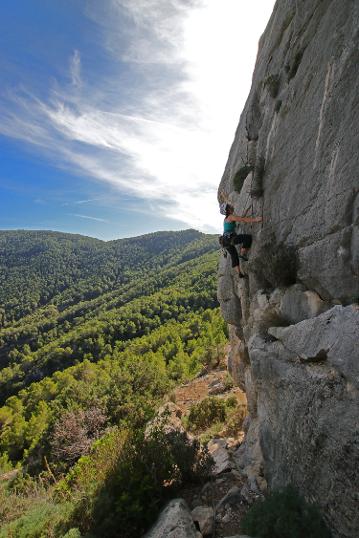
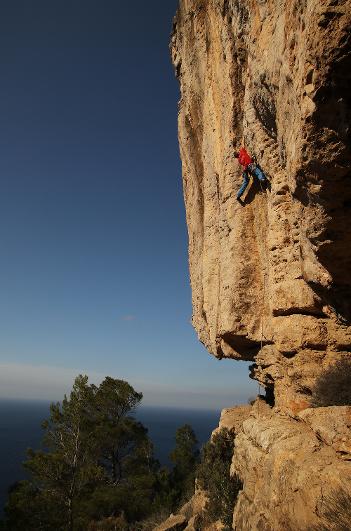
The Climbing
Almost all of the climbing is on sea cliffs or outcrops in the north of the island, with the huge crags of Buda in the southwest being the obvious exception.
Cap de Balansat
Located next to the popular little resort of Port de Sant Miquel, the main attraction of this headland is the superb cliff of Cap Creu, where an adventurous abseil approach gains a handful of long (6-pitch) sport routes. Schmiedelino (F5c) and Cielo y Infierno (F6b) are the most popular, but there are also a few harder offerings up the huge overhanging cliff to the right.
Isla Blanca
With a mixture of sea cliffs and inland outcrops, this is one of the most varied climbing spots on the island. At the popular Sector Sol and Sector Sombra you’ll find dozens of single-pitch bolted routes between F4 and F8a+, with the majority of lines around the F5+ to F6c grades. As the name suggests, sunshine or shade are both available, and the pleasant woodland setting makes these sectors a great choice throughout the year.
Below Sol and Sombra are the even better sea-cliffs of Sector Faders, home to about thirty well-bolted single pitch routes right above the ocean. The routes here stay in the shade and on hot, calm days you can cool off with a dip in the amazing blue waters. Although there are a handful of harder climbs (up to F8b), the routes are mostly around the F5a to F6b grades.
Just to the west, the adventurous Punta de Aguila is home to many adventurous multi-pitch routes in a dramatic setting, as well as the spectacular roof of Guerrero Solar (F8a).
Cap de Rubio
A little more remote than many of the areas, the crags of Cap de Rubio have a brilliant, wild feel to them. On the eastern side, the Cueva de Egagropilas is one of the best spots on the island for hard steep roofs and tufas, with a selection of excellent 7’s and 8’s up some seriously steep limestone.
For those who prefer something a little more amenable, the nearby outcrops of Egagropilas are home to lots of single-pitch routes in a beautiful, remote forest. For the easiest lines, check out Sector Ses Plaques, where you’ll find some of the best grade 5 pitches on perfect, unpolished limestone slabs.
On the west side of the headland, the main attraction is the popular outcrop of Jolibud, where local climbers have put up some of the hardest routes on Ibiza. Whilst it may not be as pretty as some venues, this veritable outdoor gym is a great place to test yourself on some outrageously steep, well-bolted athletic routes exclusively in the upper grades.
Cap Aubarca
Well known for its ancient fortifications, this large headland attracts lots of visitors, both climbers and tourists alike. If you want to avoid the crowds then you can always head for the brilliant Stairway to Heaven (F6a) – a 9-pitch route up a striking limestone pillar above Cala Aubarca. The first four pitches need a bit of trad gear, but the climbing is fairly easy (F4), until you reach the well-bolted pillar above.
The headland is also home to northern Ibiza’s main sport crag, Torre de Lluc. This massive west-facing vertical wall is home to almost sixty routes from F5+ to F8a and is one of the most popular climbing venues on the island. Highlights include Pantera Floja (F6a+) and Fisura Ramon (F7a+), but almost all of the lines here are worth doing.
Sant Antoni
For climbers staying in Sant Antoni, the nearest crags are the little outcrops of Ses Fontanelles on the island’s northwest corner. These buttresses are home to a good selection of climbs, up to about fifteen metres in height, all right above the track just 10 minutes from the car. Don’t miss the impressive overhangs of Sector Odisea, or the pleasant easy routes on the 2nd Buttress.
Buda
Ibiza’s original climbing crag, the headland of Buda is a massive venue, with just about every type of route from easily accessible single-pitch grade 5s to awe-inspiring multi-pitch grade 8 testpieces. In the incredible Anfiteatro you can also find a selection of huge roof climbs, hundreds of metres above the sea.
Not surprisingly, the chilled-out Sector Rampante sees plenty of attention with its collection of grade 5 routes just 10 minutes from the car. From there, many people progress to the even better Sector Colorado, which holds the crags biggest selection of mid-grade climbs, both single- and multi-pitch.
Santa Eularia
Although it’s a relatively minor outlying crag, the pleasingly named Sector Siesta near the town of Santa Eularia is well worth a visit for some brilliant single-pitch routes right above the sea. The crag gets lots of morning sunshine, but is shady in the afternoon, making it possible to climb here throughout the year.
Logistics
As one of the Mediterranean’s busiest tourist destinations, it’s no surprise that holidays to Ibiza are cheap and easy to organise. Here are a few top tips…
When to Visit
It is possible to climb in Ibiza throughout the year, though in general the spring and autumn give the best conditions.
The summer tourist season runs from the middle of May through to early October, during which the main towns and beaches are likely to be busy. The sea cliffs along the north coast, however, provide a peaceful escape from the crowds and many north-facing cliffs are climbable even in hot weather.
By the middle of October, many tourist facilities, bars and restaurants begin to close for the winter. From then until April the island is very quiet, though it is still possible to find flights and accommodation. Some of the crags can be slippery in winter due to the humidity, particularly when there’s a sea breeze.
May, June, September and early October probably provide the best compromise, when all of the facilities are open, flights are cheap, and temperatures are ideal for climbing at almost all of the crags.
Getting There
Ibiza airport handles some 6 million passengers each year, so it will come as no surprise to learn that flights to the island are frequent and cheap, with budget airlines operating services from all over Europe.
From the UK, daily flights operate from spring to autumn from a variety of airports including London, Manchester, Liverpool and Glasgow.
For those looking to include Ibiza as part of an overland trip through Europe, the island is easily accessible by ferry from Valencia in Spain, with tickets varying between £100 and £200 depending on time of year.
Where to Stay
The two main accommodation options are hotels in the resorts or self-catering fincas in the countryside. Prices and availability vary enormously by season.
Staying in one of the resort hotels is usually the cheapest option, particularly in spring and autumn outside of the main tourist season. The lively town of San Antonio has the widest range of hotel accommodation, though some of it is very 'low-budget' and the town can be a bit raucous during the clubbing season.
Further north, the village of Port Sant Miquel is probably a better option. This much smaller resort has fewer hotels to choose from, but has a lot more character whilst still providing all of the amenities such as bars, shops, restaurants and a good beach. Its main advantage, however, is the fact that it is very well situated for most of the climbing on the island's north coast.
For groups or visitors looking for self-catering accommodation, many villas (fincas) are available throughout the island's interior. These can easily be found and booked online.
Eating Out
Between May and October there are a huge number of options to suit all budgets. During the winter, many restaurants close and it may be preferable to self-cater.
Equipment
A standard rack of about 12 to 15 quickdraws and a couple of slings is all that is required to climb most of the routes on Ibiza. A small selection of trad gear (a set of nuts and perhaps a couple of cams) is needed to supplement in-situ equipment on a small number of routes, though it is perfectly possible to enjoy a trip here without needing to place any trad gear. With some abseils up to 30 metres in height, a single 60-metre rope is advised.
Of course, don’t forget the sun cream and swimming gear, as the beaches on Ibiza are far too tempting to ignore.
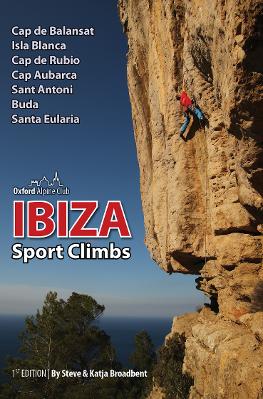
Family Holidays
Contrary to expectations, Ibiza is a brilliant place for a family holiday, but it’s worth pointing out a few limitations. Most of the island’s crags are not very child-friendly, either because access requires some scrambling, or because the area at the base of the climbs is not suitable for children to play. If you’re lucky enough to be able to team up with others and arrange childcare, however, the amazing bays and calm, shallow waters make Ibiza a paradise for kids who enjoy a day on the beach.
Guidebook
Ibiza Sport Climbs (published by the OAC, 2020) is the most up-to-date guidebook, describing more than 630 routes in all of the main climbing areas.
Find out about our range of topographic maps and cartography services
Read about publishing services offered by the OAC
